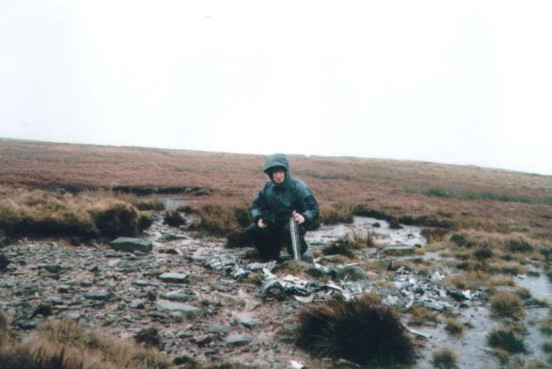Avro Vulcan B. Mk.2 XH536 of the RAF Cottesmore Wing, flew into Fan Bwlch Chwyth in the Brecon Beacons on the 11th February 1966 while on a training flight. The aircraft struck near the top of the hill and broke apart over a large area.

| Graham Howard Sutcliffe | Flying Officer | Pilot | Killed |
| John Donald MacDonald | Flight Lieutenant | Pilot (Aircraft Captain) | Killed |
| Roger Clare | Flight Lieutenant | Navigator Radar | Killed |
| Brian Waring | Flight Lieutenant | Navigator Plotter | Killed |
| Geoffrey Edward Fuller | Flight Lieutenant | Air Electronics Officer | Killed |
The crew of Vulcan XH536, from No.9 Squadron, took off at 13:26 on the 11th February 1966 from RAF Cottesmore near Oakham in Rutland for a cross country flight.
The first part of the flight was to be conducted at high level before descending towards the Bristol Channel for a low level stage through Wales and over the Irish Sea to perform a practice low level attack against RAF West Freugh in south west Scotland and then returning at medium level to Cottesmore.
The weather forecast for the low level section was for a solid layer of low cloud from 2,000 feet and further scattered cloud below this with some light snow showers, visibility was forecast to be up to 4 miles, but falling to as little as 50 yards in hill fog.
Shortly before XH536 entered the low level route a pair of Hawker Hunters had attempted to follow the same route through Wales at a slightly lower height than that planned for XH536. They were able to fly up the Vale of Neath but on reaching the valleys north of Glyn-neath the second pilot could see the snow covered high ground ahead appearing to merge into the clouds with no clear horizon so called to the leading pilot to climb up through the cloud to a safe altitude. Also ahead of XH536 was another Vulcan, on reaching the entry point to the low level route the Captain obtained a weather forecast from two near by air stations and on the basis of this elected not the follow the low level route, but instead flew onwards at 5,500ft.
Two minutes later the pilots of XH536 began their descent from 40,000ft over the English Channel heading north across Devon, they obtain air pressure data for the two flight regions they would be passing through and continued descending to 1,500ft over the Bristol Channel by which time they were below the low cloud. The aircraft turned onto a north easterly heading over Resolven in the Vale of Neath and was seen below the cloud following the valley before turning slightly to port to try and follow the Llia valley to reach the Senni valley beyond. It would appear that at this point, while flying at around 450mph in poor visibility, the crew had misidentified the Llia valley and had flown up the Nedd Fechan valley just over 1 mile to the west. On reaching the head of the valley they turned to starboard expecting to flying over the centre of the Senni valley, however having flown up the wrong valley the aircraft was over the high ground on the NW side of Senni valley. Shortly afterwards the aircraft struck the south western side of Fan Bwlch Chwyth and broke up over a half mile stretch of the hilltop. A sound which was thought by some to be that of blasting in nearby quarries, but was actually that of the aircraft exploding, was heard at 15:10 by people around Heol Senni, this was only 3 minutes after the aircraft had passed the Welsh coast.
As the aircraft had entered the low level flying area it had gone below local radar coverage and when nothing further was heard from the crew a search had begun, centred on the southern end of the planned low level route. Overnight ground teams had been walking the hills of the Brecon Beacons but had not seen anything. During the 12th February the crew of a search and rescue helicopter spotted a long trail of wreckage and burnt ground across the top of Fan Bwlch Chwyth. After flying around the crash site they flew to the nearest Mountain Rescue party to pick them up and transfer them to the crash site. The MRT placed a Search & Rescue Beacon at the crash site in case the weather closed in again. After this the helicopter crew landed at Heol Senni to call the rescue co-ordination centre as the high ground and weather was preventing them from making radio contact.
The investigation which followed found that the aircraft had struck the hill some 70 feet below the summit of the ridge with the wings virtually level and with a slight nose up attitude. The heavier pieces of the aircraft, the four Olympus engines and under-carriage had broken free and travelled the furthest from the point of impact. Both main under-carriage oleos had cleared the wall which crosses the northern end of the hill just above the then active quarry. None of the workers at the quarry had heard the crash, though people in the valley below had heard the explosion.


